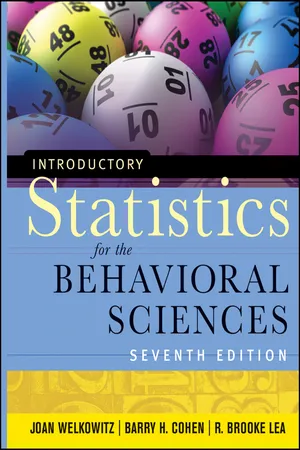![]()
Part I
Descriptive Statistics
Chapter 1 Introduction
Chapter 2 Frequency Distributions and Graphs
Chapter 3 Measures of Central Tendency and Variability
Chapter 4 Standardized Scores and the Normal Distribution
![]()
Chapter 1
Introduction
Preview
Why Study Statistics?
What are four important reasons why knowledge of statistics is essential for anyone majoring in psychology, sociology, or education?
Descriptive and Inferential Statistics
What is the difference between descriptive and inferential statistics?
Why must behavioral science researchers use inferential statistics?
Populations, Samples, Parameters, and Statistics
What is the difference between a population and a sample?
Why is it important to specify clearly the population from which a sample is drawn?
What is the difference between a parameter and a statistic?
Measurement Scales
What types of scales are used to measure variables in the behavioral sciences?
Independent and Dependent Variables
What is the difference between observational and experimental studies?
Summation Notation
Why is summation notation used by statisticians?
What are the eight rules involving summation notation?
Ihno's Study
An example that provides a common thread tying together all of the subsequent chapters
Summary
Exercises
Thought Questions
Computer Exercises
Bridge to SPSS
Why Study Statistics?
This book is written primarily for undergraduates majoring in psychology, or one of the other behavioral sciences. There are four reasons why a knowledge of statistics is essential for those who wish to conduct or consume behavioral science research:
1. To understand the professional literature. Most professional literature in the behavioral sciences includes results that are based on statistical analyses. Therefore, you will be unable to understand important articles in scientific journals and books unless you understand statistics. It is possible to seek out secondhand reports that are designed for the statistically uninformed, but those who prefer this alternative to obtaining firsthand information probably should not be majoring in the fields of behavioral science.
2. To understand and evaluate statistical claims made in the popular media. This is a relatively new reason to acquire quantitative reasoning skills: The “Information Age” of the early 21st century has ushered in an explosion of quantitative claims in newspapers, television, and the Internet. Unfortunately, the difference between claims that are statistically sound and those that merely appear that way can be difficult to detect without some formal training. You will make many important life decisions over the next decade that will require weighing probabilities under conditions of uncertainty. A competence with basic statistics will empower you to make maximal use of the available information and help protect you from those who may wish to mislead you with pretty graphs and numbers.
3. To understand the rationale underlying research in the behavioral sciences. Statistics is not just a catalog of procedures and formulas. It offers the rationale on which much of behavioral science research is based—namely, drawing inferences about a population based on data obtained from a sample. Those familiar with statistics understand that research consists of a series of educated guesses and fallible decisions, not right or wrong answers. Those without a knowledge of statistics, by contrast, cannot understand the strengths and weaknesses of the techniques used by behavioral scientists to collect information and draw conclusions.
4. To carry out behavioral science research. In order to contribute competent research to the behavioral sciences, it is necessary to design the statistical analysis before the data are collected. Otherwise, the research procedures may be so poorly planned that not even an expert statistician can make any sense out of the results. To be sure, it is possible (and often advisable) to consult someone more experienced in statistics for assistance. Without some statistical knowledge of your own, however, you will find it difficult or impossible to convey your needs to someone else and to understand the replies.
Save for these introductory remarks, we do not regard it as our task to persuade you that statistics is important in psychology and other behavioral sciences. If you are seriously interested in any of these fields, you will find this out for yourself. Accordingly, this book does not rely on documented examples selected from the professional literature to prove to you that statistics really is used in these fields. Instead, we have devised several artificial, but realistic, examples with numerical values that reveal the processes and issues involved in statistical analyses as clearly as possible.
One example we use throughout this text is based on a hypothetical study performed by a new student named Carrie on the relative friendliness of four dormitory halls on her campus. We present the data for this study in the first exercise at the end of this chapter and return to it in many of the subsequent chapters.
We have tried to avoid a “cookbook” approach that places excessive emphasis on computational recipes. Instead, the various statistical procedures and the essential underlying concepts have been explained at length, and insofar as possible in standard English, so that you will know not only what to do but why you are doing it. Do not, however, expect to learn the material in this book from a single reading; the concepts involved in statistics, especially inferential statistics, are sufficiently challenging that it is often said that the only way to completely understand the material is to teach it (or write a book about it). Having said that, however, there is no reason to approach statistics with fear and trembling. You certainly do not need any advanced understanding of mathematics to obtain a good working knowledge of basic statistics. What is needed is mathematical comprehension sufficient to cope with beginning high school algebra and a willingness to work at new concepts until they are understood, which requires, in turn, a willingness to spend some time working through at least half of the exercises at the end of each chapter (and, perhaps, some additional exercises from the online Study Guide).
Descriptive and Inferential Statistics
One purpose of statistics is to summarize or describe the characterist...
